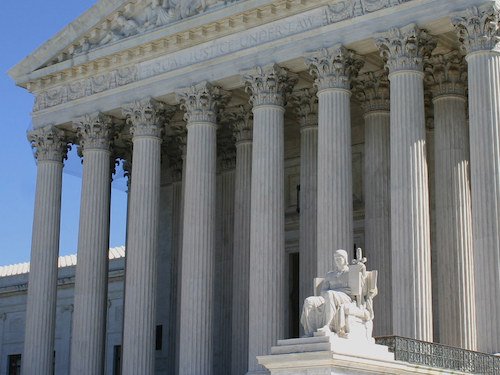
With the United States Supreme Court widely expected to turn its ideological wrecking ball on the country’s greenhouse gas emission controls, a group of climate scientists is pitching a new approach to regulating carbon as a toxic substance.
The nine-member court is believed to be just days away from handing down a decision “that could severely limit the federal government’s authority to reduce carbon dioxide from power plants,” the New York Times reported last week.
Climate specialist Coral Davenport described the expected outcome in the case, West Virginia v. Environmental Protection Agency, as “the product of a coordinated, multi-year strategy by Republican attorneys general, conservative legal activists, and their funders, several with ties to the oil and coal industries, to use the judicial system to rewrite environmental law, weakening the executive branch’s ability to tackle global warming.”
The stakes in this and other upcoming court battles are incredibly high, Davenport added.
“Victory for the plaintiffs in these cases would mean the federal government could not dramatically restrict tailpipe emissions because of vehicles’ impact on climate, even though transportation is the country’s largest source of greenhouse gases,” she wrote. “The government also would not be able to force electric utilities to replace fossil fuel-fired power plants, the second-largest source of planet warming pollution, with wind and solar power. And the executive branch could not consider the economic costs of climate change when evaluating whether to approve a new oil pipeline or similar project or environmental rule.”
Those legal limits on the world’s biggest historical carbon polluter “would quite likely doom the world’s goal of cutting enough emissions to keep the planet from heating up more than an average of 1.5°C compared with the pre-industrial age.”
But with this month’s decision still pending, a group of climate scientists and advocates petitioned the EPA June 16 to regulate GHGs—not under the Clean Air Act, the focus of the Supreme Court case, “but under a law no one has yet applied to climate change, the Toxic Substances Control Act,” the Drilled podcast reported.
EPA staff knew the Supreme Court decision was coming, and have been “running around wishing they could do something,” said Donn Viviani, a former EPA scientist who filed the petition along with veteran climate scientist James Hansen, psychiatrist Lise Van Susteren, atmospheric chemist John Birks, and Richard Heede, co-founder of the Climate Accountability Institute.
U.S. law gives the EPA 90 days to respond to the petition “with a determination as to whether carbon dioxide, methane, and other heat-trapping gases pose ‘an unreasonable risk of injury to health or the environment’,” the Washington Post writes. After that, “EPA would have to formulate and implement rules that could, for example, impose a fee on carbon emissions—and also require companies to remove carbon from the atmosphere they have already expelled.”
The authority to regulate carbon pollution under the TSCA “has been hiding in plain sight the entire time,” Viviani told Drilled co-host Amy Westervelt.
“There was sort of a perceived wisdom” that the legislation wouldn’t serve the purpose, he explained, after the agency lost a landmark ruling on asbestos regulation. “It was actually the Agency’s fault because they didn’t do their due diligence,” he said, but after the asbestos decision “they kind of threw up their hands and said ‘we have to work under the Clean Air Act’, which is an abysmal law.”
Yet the TSCA was designed to deal with pollutants “that the other laws weren’t properly taking care of,” and was used in 1978 to regulate the chlorofluorocarbons (CFCs) that were endangering the ozone layer. Like carbon dioxide, “CFCs are also a gas,” Viviani told Drilled, so “there actually is strong precedent in EPA’s own actions [for] utilizing this statute to kickstart an effort to get rid of that potent pollutant.”
The TSCA “is well situated to serve as a foundational statute for a wide-ranging decarbonization effort in the United States because of its very strong language,” added attorney Dan Galpern, executive director and general counsel of the non-profit Climate Protection and Restoration Initiative. “What is needed now is not merely a tinkering at the edges, but restrictions to the point of prohibition, to the point of a phaseout of greenhouse gas emissions sources, at least the major ones,” to push past net-zero emissions and bring the U.S. to net-negative by mid-century.
“What we’re trying to provide is a firm legal foundation under which these types of actions can proceed, and to avoid the recurrent and protracted deadlock in Congress over any need for any new legislation,” he added. “No new legislation is needed here. Congress acted strongly in passing the Toxic Substances Control Act, and in amending it just six years ago in 2016.”
If the EPA does decide that carbon pollution qualifies under the toxic substances act, the next question will be whether politics trump settled legislation.
“Using existing law and agreed-upon science is a clever strategy,” the Post writes. “But the major impediments to addressing climate change have always been political. The fossil fuel industry would use its vast stores of money and influence to fight EPA regulation of carbon. The Biden administration might well balk at the idea of taking any such action at a time when world energy markets are in turmoil and U.S. consumers are paying about $5 a gallon for gasoline. The conservative majority on the Supreme Court might be skeptical, if not scornful, of the idea that such sweeping change could be mandated by executive branch rulemaking.”
And yet, “it’s all there in black and white in the Toxic Substances Control Act, which passed and was amended with bipartisan support,” writes columnist Eugene Robinson. “Textualists will have to tie themselves in knots to explain why the law’s words don’t mean what they clearly say.”
But West Virginia v. EPA is not the only case U.S. climate hawks have to worry about. “Coming up through the federal courts are more climate cases, some featuring novel legal arguments, each carefully selected for its potential to block the government’s ability to regulate industries and businesses that produce greenhouse gases,” the Times says.
The case now before the Supreme Court “is unusual, but it’s emblematic of the bigger picture. AGs are willing to use these unusual strategies more,” said Marquette University political scientist Paul Nolette. “And the strategies are becoming more and more sophisticated.”
The Times points to a “tangle of connections” between the plaintiffs in the West Virginia case and the Supreme Court justices hearing the case. “The Republican plaintiffs share many of the same donors behind efforts to nominate and confirm five of the Republicans on the bench—John G. Roberts, Samuel A. Alito Jr., Neil M. Gorsuch, Brett M. Kavanaugh, and Amy Coney Barrett.”
That makes the case “a pincer move,” said ex-senior U.S. Justice Department official Lisa Graves, now executive director of True North Research, described by the Times as a progressive watchdog group. “They are teeing up the attorneys to bring the litigation before the same judges that they handpicked.”
E&E News agrees that this month’s decision could go far beyond the EPA’s regulatory authority.
“Legal experts are waiting to see if the ruling in West Virginia v. EPA begins to chip away at the ability of federal agencies—all of them, not just EPA—to write and enforce regulations,” E&E writes. “It would foreshadow a power shift with profound consequences, not just for climate policy but virtually everything the executive branch does, from directing air traffic to protecting investors.”
Source: Theenergymix.com



